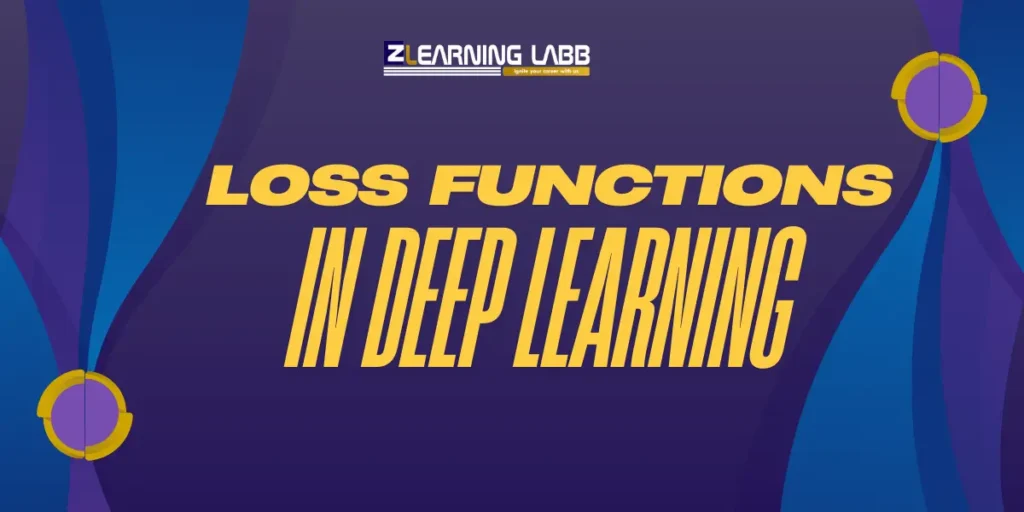Loss Functions In Deep Learning: Have you ever wondered how deep learning models learn? What makes them improve after each iteration? The secret lies in loss functions in deep learning. These functions act as the guiding force behind model optimization, helping algorithms understand how well (or poorly) they are performing.
In this blog, we will explore:
- What is loss function in deep learning?
- Types of loss function in deep learning
- What is the purpose of a loss function in deep learning?
- Difference between loss function and cost function
What is Loss Function in Deep Learning?
A loss function in deep learning is like a teacher correcting a student’s mistakes. Imagine a student taking a test—if they get some answers wrong, the teacher marks those mistakes and gives feedback. Similarly, a loss function checks how far a model’s predictions are from the correct answers and gives a numerical value (error).
The higher the loss, the more mistakes the model is making. The lower the loss, the better the model is performing. The model then uses this feedback to adjust itself and improve its accuracy over time. This process continues until the model becomes as accurate as possible.

What is the Purpose of a Loss Function in Deep Learning?
The purpose of a loss function in deep learning is to:
- Provide a measurable way to evaluate model performance.
- Help adjust weights and biases using optimization algorithms like gradient descent.
- Ensure the model learns effectively by reducing errors over time.
Without loss functions, a deep learning model would not know how to improve. That’s why they are a fundamental part of AI training.
Types of Loss Function in Deep Learning
Different problems require different loss functions. Here are the major types of loss function in deep learning:
1. Regression Loss Functions
These are used when the output is continuous (e.g., predicting house prices).
a) Mean Squared Error (MSE)
Formula:
MSE = \frac{1}{n} \sum (y_{true} - y_{pred})^2- Punishes large errors more than small ones.
- Works well for normally distributed data.
b) Mean Absolute Error (MAE)
Formula:
MAE = \frac{1}{n} \sum |y_{true} - y_{pred}|- Treats all errors equally.
- Less sensitive to outliers than MSE.
c) Huber Loss
- A combination of MSE and MAE, useful when dealing with outliers.
2. Classification Loss Functions
Used when the output is categorical (e.g., spam or not spam).
a) Binary Cross-Entropy (Log Loss)
Formula:
BCE = -\frac{1}{n} \sum [y \log(p) + (1-y) \log(1-p)]- Used for binary classification problems.
- Penalizes incorrect predictions heavily.
b) Categorical Cross-Entropy
- Used when there are multiple classes.
- Helps the model assign probabilities to different categories.
c) Hinge Loss
- Used for Support Vector Machines (SVMs) in classification.
- Encourages maximum margin separation.
Difference Between Loss Function and Cost Function
Many beginners get confused between the difference between loss function and cost function.
| Features | Loss Function | Cost Function |
| Definition | Calculates error for a single data point | Averages the loss over the entire dataset |
| Example | MSE for one sample | MSE for all samples in a batch |
| Usage | Used in backpropagation | Used to optimize the entire model |
Simply put, the loss function works on an individual level, while the cost function aggregates errors across all training examples.
Choosing the Right Loss Function in Deep Learning
Selecting the correct loss function in deep learning depends on the type of problem you are solving:
- Regression: Use MSE or MAE.
- Binary Classification: Use Binary Cross-Entropy.
- Multi-Class Classification: Use Categorical Cross-Entropy.
- Outliers in Data: Use Huber Loss.
If you are struggling with loss functions, Ze Learning Labb offers expert-led courses that simplify deep learning concepts for you.
How Loss Functions Help Model Training
Loss functions play a critical role in deep learning training. They:
- Guide the optimizer (like Adam or SGD) to improve model parameters.
- Reduce training errors step by step.
- Ensure better generalization by preventing overfitting.
Without an appropriate loss function, even the best deep learning architectures will fail.
Common Pitfalls When Using Loss Functions
While training deep learning models, beginners often make mistakes. Here are a few to watch out for:
1. Choosing the Wrong Loss Function
- Using MSE for classification? That’s a mistake!
- Using cross-entropy for regression? Another error!
2. Not Normalizing Data
- Loss functions like MSE work better when data is properly scaled.
3. Ignoring Overfitting
- A low training loss but high validation loss means your model is memorizing rather than generalizing.
Want to avoid these mistakes? Join Ze Learning Labb’s courses and train like a pro!

On A Final Note…
Loss functions in deep learning are like guiding lights—they help models navigate towards better accuracy. Understanding what is loss function in deep learning, the types of loss function in deep learning, and the difference between loss function and cost function is essential for AI success.
The best way to learn deep learning is to practice—start with small models and experiment with different loss functions. If you want to master loss functions and deep learning, Ze Learning Labb offers hands-on courses with real-world projects. Start your AI journey today!





